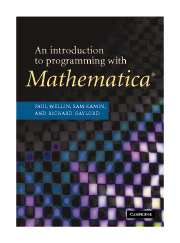Book contents
- Frontmatter
- 1 An introduction to Mathematica
- 2 The Mathematica language
- 3 Lists
- 4 Functional programming
- 5 Procedural programming
- 6 Rule-based programming
- 7 Recursion
- 8 Numerics
- 9 Graphics programming
- 10 Front end programming
- 11 Examples and applications
- 12 Writing packages
- Appendix A How expressions are evaluated
- Appendix B Debugging
- References
- Solutions to exercises
- Index
10 - Front end programming
Published online by Cambridge University Press: 21 March 2011
- Frontmatter
- 1 An introduction to Mathematica
- 2 The Mathematica language
- 3 Lists
- 4 Functional programming
- 5 Procedural programming
- 6 Rule-based programming
- 7 Recursion
- 8 Numerics
- 9 Graphics programming
- 10 Front end programming
- 11 Examples and applications
- 12 Writing packages
- Appendix A How expressions are evaluated
- Appendix B Debugging
- References
- Solutions to exercises
- Index
Summary
In this chapter we extend the programming concepts we have covered thus far to the objects that comprise the user interface, or front end. Because the objects that the Mathematica user interacts with are themselves Mathematica expressions, all of the tools that you use to do computations can also be used to create, manipulate, and alter cells and notebooks themselves. We will first look at the underlying structure of these objects and then discuss ways of manipulating them directly from within Mathematica.
Introduction
Up until this point, we have been primarily concerned with learning about programming constructs and styles so that we can write programs to manipulate data or solve problems from science, engineering, or mathematics. We have taken for granted that the space in which we do our experimenting, prototyping, and documenting has been the Mathematica notebook, an interface that has some similarities to a word processor document.
It is not uncommon now to add interactive elements to your documents to make them more useful for yourself or the intended reader of your documents. With programs, documentation, and papers all being created and used in electronic format, Mathematica provides a seamless and well-integrated interface to these elements.
Another tool that is useful, especially for educators, are buttons that allow you to hide your program code behind a familiar and easy-to-use interface element – the button. The user clicks on a button and an action happens that is determined by the underlying code.
- Type
- Chapter
- Information
- An Introduction to Programming with Mathematica® , pp. 309 - 340Publisher: Cambridge University PressPrint publication year: 2005

